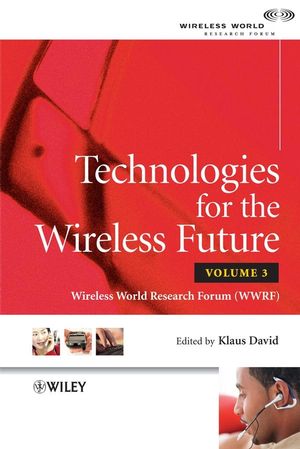Technologies for the Wireless Future: Wireless World Research Forum (WWRF), Volume 3ISBN: 978-0-470-99387-3
Hardcover
506 pages
October 2008
 |
||||||
Contents
List of Figures
List of Tables
List of Contributors
Foreword by Dr Atsushi Murase
Foreword by Charles Backof
Preface
Acknowledgements
1 Introduction
Edited by Dr Nigel Jefferies (Vodafone Group R&D, UK) and Prof. Dr Klaus David (ComTec, University of Kassel, Germany)
1.1 A Book of Visions
1.2 The Wireless World Research Forum
1.3 Current Situation and Trends
1.4 Overview of the Following Chapters
2 Vision and Stakeholder Requirements for Future Mobile Systems
Edited by Dr Nigel Jefferies (Vodafone Group R&D, UK)
2.1 A Vision of 2017
2.2 Stakeholder Requirements
2.3 Acknowledgements
3 User Requirements, Scenarios and Business Models
Edited by Lene Sørensen and Knud Erik Skouby (Center for Information and Communication Technologies/IMM, Danish Technical University, Denmark)
3.1 Introduction
3.2 Scenarios
3.3 User Requirements
3.4 A User-centred Approach to Service Development
3.5 Usability
3.6 Business Modeling
3.7 Conclusions and Further Research
3.8 Acknowledgements
4 Service Infrastructures
Edited by Prof. Dr Klaus David (ComTec, University of Kassel, Germany) and Dr Mika Klemettinen (Nokia, Finland)
4.1 Introduction
4.2 Semantic Services
4.3 Service Creation
4.4 Service Architecture for the Wireless World
4.5 Acknowledgements
5 The WWI System Architecture for B3G Networks
Edited by Andreas Schieder (Ericsson GmbH, Germany), Elias Tragos (National Technical University of Athens, Greece), Andrej Mihailovic (King’s College London, UK), Jukka Salo (Nokia Siemens Networks, Finland) and Jan van der Meer (Ericsson Telecommunicati, The Netherlands)
5.1 Introduction
5.2 Heterogeneous Radio Resource Management (HRRM) in the WWI System Architecture
5.3 Mobility
5.4 Context Provisioning
5.5 Network Management in the WWI System Architecture
5.6 Conclusions
6 New Air Interface Technologies
Edited by Dr Angeliki Alexiou (Bell Labs, Alcatel-Lucent, UK) and Dr Gerhard Bauch (DoCoMo Euro-Labs, Germany)
6.1 Introduction
6.2 Error Control Coding Options for Next-generation Wireless Systems
6.3 Multi-dimensional Channel Modeling
6.4 Multi-user MIMO Systems
7 Short-range Wireless Communications
Edited by Prof. Rolf Kraemer (IHP, Germany) and Marcos Katz (VTT, Finland)
7.1 Introduction
7.2 Integrative and Cooperative Aspects of Short-range Communications: Technologies, Designing Rules and Trends
7.3 Ultra Wideband Radio over Optical Fibre
7.4 Work in Progress
8 Emerging Technologies to Support Reconfigurable Cognitive Wireless Networks
Edited by Prof. Panagiotis Demestichas, George Dimitrakopoulos and Yiouli Kritikou (University of Piraeus, Greece)
8.1 Introduction
8.2 Overview of Cognitive Wireless Networks
8.3 Management Mechanisms for Cognitive Wireless Networks
8.4 Supplementary Knowledge Features in Support of Cognition
8.5 Summary
9 Methods for Spectrum Sharing
Edited by Sudhir Dixit (Nokia Siemens Networks)
9.1 Introduction
9.2 Spectrum Sharing CategoriesBased on Centralized and Distributed Approaches
9.3 Problems and Issues in Flexible Spectrum Use
9.4 Conclusion
9.5 Acknowledgements
10 Ultra Broadband Home Area Network
Edited by Djamal-Eddine Meddour (Orange Labs, France Telecom Group)
10.1 Introduction
10.2 Applications Challenges
10.3 Connectivity
10.4 Access Challenges
10.5 Architecture
10.6 Conclusion
10.7 Acknowledgements
11 Combined View of Future Systems
Edited by Mikko A. Uusitalo (Nokia Research Center)
11.1 Introduction
11.2 Applications and Services
11.3 IP-based Communication Subsystem
11.4 Access Network
11.5 Development of Reconfigurability and Cognitive Wireless Networks
11.6 Other End-to-end Aspects
11.7 Summary and Conclusion
11.8 Acknowledgements
Appendix: Glossary
Index



